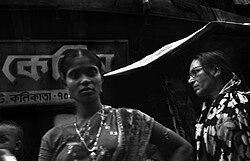History of prostitution
A farcical short-drama book named Beshyaleela ( বেশ্যালীলা ) was printed in the middle of the year 1880 written by an anonymous writer ( অজ্ঞাতনামা ). It is not very familiar or much discussed book till now. In this drama, a good description can be found about the negative attitudes shown by the then existing 19th century educated Bengali Babu class of people towards the prostitutes and the prostitution. From the first half of the 19th century, centering on Sonagachhi, a huge organised prostitution area surrounding Cornwallis Street (Now Bidhan Sarani) on the east, and Chitpur on the west were formed. Although many areas in Calcutta were inhabited by those prostitutes outside those areas also. On the south it was Kalighat to Khidirpur dock areas, in the middle-Calcutta it was Kalinga-Fenwick Bazar, on the far south in Kareya area many girls from different social-classes of Hindu-Muslim-Christian communities were engaged with this profession. More than that, there was no clear 'mark' or 'boundary-line' between the 'gentleman areas' and the 'prostitutes areas'. Many areas had scattered or mixed up population of those two kinds. Rather, many areas could be termed as 'half-gentleman' areas, where normal gentleman's families and various types of prostitutes co-existed side by side. From the middle of the 19th century, the British colonial administration, Christian Missionaries, and native English-knowing educated 'Victorian' Indian gentlemen started campaign against prostitutes. This was their part of the project of social 'sanitation' process for creating the so-called 'gentle-society'. Under the leadership of Mr. Kaliprasanna Singha, the 'Vidyotsahini Sabha' ( বিদ্যোৎসাহিনী সভা ) submitted one mass-petition in the Indian Legislative Council.

